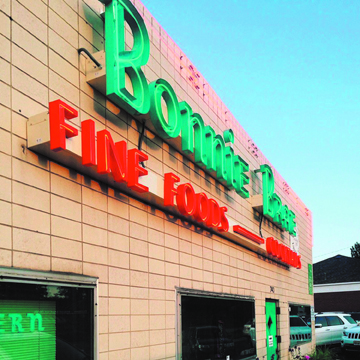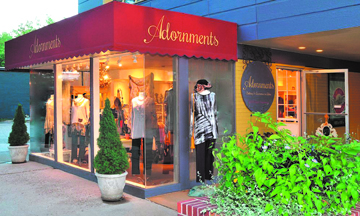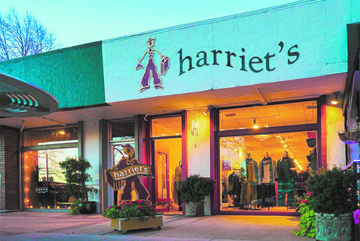
Mad Peaches




by Glen Richardson
One of the Cherry Creek Valley’s longest continually owned and operated family businesses is about to become history. The long-running Bonnie Brae Tavern that opened in 1934 with an old-school ambiance, dishing out red-sauce Italian and American dishes, is likely to be scraped-off by redevelopment.

Early-stage development plans submitted to the city indicate that the 0.76-acre site at 740 S. University Blvd. will be replaced by a 40-foot, three-story building with 43 apartments plus, in theory, 16,500-sq.-ft. of retail on the ground floor. The development would also have one level of below-ground parking. At this point there is no guarantee that the plot will in fact be sold or exactly what any development will look like. Some anticipate that the retail will be jettisoned as it has been in other so-called “mixed use” projects and the entire development will simply be one more apartment/condominium project. The property owners have obtained a non-historic designation for the building and demolition certificate which is valid until May 1, 2024.
Plans are listed under the name Joe Jundt who is developing the project with two local partners. Jundt reportedly envisions one of the floor-level retail units as a higher-end restaurant, noting the area is surrounded by pricey Belcaro and Wash Park homes. A Bonnie Brae Tavern rebirth is unlikely, however, as there have been no discussions of the Tavern reopening in the project.
Changing History
The east end of the Tavern building is leased to In & Out Cleaners. The Tavern property also includes the building at 750 S. University. Formerly a Bank of the West site, the building now is home to Wish Gifts. Both businesses would be demolished according to plans for the new project.

Carl and Sue Dire bought the block of land in 1933 when University Boulevard was a dirt road. The Dires opened a gas station on the corner and Bonnie Brae Tavern was opened at its current location in 1934, the same family still runs it. Looking east was sagebrush as far as the eye could see until Colorado Boulevard, interrupted by a dairy farm or two. To the west, instead of today’s pop-tops of prime real estate, there were modest bungalows of a young neighborhood named Washington Park.
The tavern’s lack of pretentiousness made it a favorite hangout for those in Glendale who viewed themselves at the time as far more agrarian than urban. Well into the 1950s Bonnie Brae Tavern was considered by many as part of greater Glendale rather than Denver.
Carl Dire – he died in 1982 – invested every dime he had in the weeds and dirt along the east side of the street. With prohibition out, Dire had decided to open a bar in what was one of the driest neighborhoods in Denver. Dire and his wife Sue – she passed away in 2002 – named the business after the housing development Bonnie Brae that surrounded it. Like the restaurant, the neighborhood took time to grow into its name, which is Gaelic means “pleasant hill.” In 1934, it was nothing more than a scandal-ridden development that had gone bankrupt a few years earlier.
High Property Taxes Drive Sale
The impetus for the proposed sale has been the steep rise in property taxes for commercial property in the City and County of Denver. The last tax bill increased the levy by $30,000 for a $73,000 total. The owners noted that some businesses in the area are paying as much as $10,000 a month, which he finds would be prohibitive for many small independent businesses. It brings into question for some, can the Bonnie Brae commercial area on University survive? The old “Campus Lounge,” long a popular hangout like Bonnie Brae Tavern, is on its third proprietor in just a few years. As many small businesses are fleeing Denver, some do hang on as highlighted in the article on Page 1, “Old School Holdouts.”

District Ponders Beverly Hills Hip Vs. NY Village Vibes; Dumpsters On Street Plus Sardine Can Size Micro Apartments
by Glen Richardson
In 2018 Cherry Creek North projected completion of nine out of 10 of its building projects, but as the new decade begins the flurry of construction shows no sign of slowing. The neighborhood has slapped on so much development in the past half-dozen years many residents and small business owners are wishing for a moratorium to absorb the growth.

The pace of development-driven change has been head-spinning, adding millions of square feet of apartment and commercial space while upending shopping and crushing the streetscape, parking and vibe of the district.
In addition to lack of planning for and management of projects, construction workers and developers have total control of the streets with little or no concern for shoppers or retail owners. Equally disturbing, the district still hasn’t decided on a direction to take to make the district an attractive destination.
Beverly Hills Look
At the Cherry Creek North Business Improvement District’s December board meeting, BID officials once again contemplated trying to become Beverly Hills. It was the third time the board has listened to Emzy Veazy III tell them how to copy Beverly Hills and retake lost marketing share and become a world class destination. He also attended and addressed BID in 2006 and 2017.

Beverly Hills, of course, is known as one of the most fashionable places to shop. In the heart of it all sits Rodeo Drive — one of the most famous streets on the globe. It has more than 100 world-renowned stores and hotels along its three blocks.
BID board member Terri Garbarini — owner of a Cherry Creek women’s shop for more than 20 years — has pushed for the Beverly Hills image. She once told the Denver Business Journal, “Cherry Creek has become Beverly Hills without pretentiousness — and business wants in.” She originally had a shoe store in Larimer Square, then relocated to Cherry Creek and reopened as a dress shop on 3rd Ave. In 2013 Garbarini paid $5 million for the building at 239 N. Detroit St. and moved into the larger space.
Or New York Style
Meanwhile Matt Joblon — CEO of BMC Investments and another BID Board Member — has been transforming the district into something much more like New York’s Greenwich Village. His projects have added New York style hotels and eateries to Cherry Creek. Joblon’s $30 million makeover of the Inn at Cherry Creek underway on Clayton St. is being designed as an 18-hour-a-day nightlife hub similar to those in the Village.

Referred to as the “Village” by New Yorkers, its history is artsy and edgy. It is eminently walkable, and may have more culture per square foot than any other area of New York. Today it also features sleek new construction, upscale restaurants and dozens of gyms.
Jokingly introduced by former Neighborhood Assn. President Robert Vogel as the man who wants to change the district’s name to “Joblonville,” BMC built the Steele Creek Apartments, Halcyon Hotel, the Financial House and St. Paul Collection. Projects scheduled to start this year include a five to seven-story structure with retail on Fillmore St. and a six-story Equinox Fitness building on St. Paul
Eateries, Retail Turmoil
Not all of the BID board, however, has benefited from the district’s massive construction projects. Marshall Miranda closed his distinctive Bombay Clay Oven on Steele St. in April of last year. A Cherry Creek fixture since 1997, he blamed the closure on “several years of heavy construction that made access to the eatery difficult and parking all but impossible.” Laurel Cherry Creek, a 12-story luxury condo opened several months later.

Hedge Row — the restaurant across from Miranda’s eatery at 100 Steele St. — shuttered before Miranda called it quits. Kitchen Restaurant Group co-founder Kimbal Musk blamed parking shortages and constant lane closures for the decision. Construction was also a factor for the Thirsty Lion closure. Harmon’s Eat & Drink didn’t renew its least on East 2nd Ave. blaming rent increases. Even Wolfgang Puck couldn’t make it in Harmon’s space.
Cherry Creek’s retail has also struggled due to the unmanaged building boom and rapidly rising rents. After five years in the upscale Fillmore Place development, the Hallmark store at 2940 E. 2nd Ave. closed in January. The store’s lease ended last July but remained open through the holidays paying rent monthly. The Jonathan Adler’s store at 158 Fillmore St. in Cherry Creek also closed last year. The high-end furnishings brand was the only Adler store in the region. Other closures included Eccentricity, a women’s clothing, accessories and gift store at 290 Fillmore St. and St. Croix on East 3rd Ave.
Positive Shopping News
Many residents and longtime state/regional customers are concerned about the future of what has long been a neighborhood hangout for shopping, dining and entertainment. The uncertainty that comes with new construction, vacant storefronts and potential new owners makes them apprehensive.
As development triggers the departure of eateries and retail shops — particularly independent boutiques — there’s also a bit of positive news to uplift shoppers. Rather than closing Adornments, owner Helen Wicker has sold the local store to longtime manager Consuelo Diaz. Wicker has moved to Santa Fe where she owns sister store Adorn.

Diaz has managed the Cherry Creek store for 23 years, assisting the boutique’s devoted customers. “Adornments will continue the unique, stylish and artistic vision that has made the fashion store a Valley favorite,” she tells the Chronicle. The store features a continuously changing collection of clothing, jewelry and accessories. Diaz and her friendly-knowledgeable staff enjoy helping women with their individual style and finding “clothing and accessories to Adore.” Adornments is located at 2826 East 3rd Ave. Information: 303-321-7992.
Dumpsters, Micro Flats
District shop owners, however, continue to face challenges due to the uncontrolled construction. Harriet’s, a clothing boutique at 300 Fillmore, recently found a construction dumpster taking up the metered spaces in front of the shop. Owner Harriet Gibson, an unabashedly direct business woman, eventually got the dumpsters moved albeit only few spaces down the street in front of the library.

Upscale Cherry Creek North shopping faces yet another challenge: Limited land in the district is attracting another kind of development — living like fancy sardines in micro apartments. A five-story, 37-unit micro-apartment building is expected to open this spring at 135 Adams St. in Cherry Creek. Amazingly neighborhood groups couldn’t halt the Barry Hirschfeld-led development that features no parking in the already dense neighborhood.
Whether Cherry Creek chooses to imitate Greenwich Village or Beverly Hills, the district is unlikely to become an awe-inspiring destination until it becomes walkable, has parking and can attract and keep shopping boutiques, vibrant venues and restaurants that create a unique destination.

This month is one of those rare times when there are 29 days in February instead of 28. A leap in time when the calendar is adjusted to make up for extra seconds accrued over the preceding three years due to the rotation of the earth. Given it’s also Valentine’s month, we have to ask: Will you or won’t you? Should you or shouldn’t you?
According to an old Irish legend, St. Brigid struck a deal with St. Patrick to allow women to propose to men — and not just the other way around — every four years.
To help you make the leap— be it love or business — here are our choices for shopping, dining and entertainment to make you feel all warm and lovey-dovey:
3 Leap at the chance to see some of the 43 films at the Jewish Film Festival playing at the JCC’s Wolf Theatre, Feb. 5-19. Featured films include 16 Denver and six Colorado premieres. Information: 303-316-6360.
3 You’ll love the Colorado Ballet Auxiliary gala with dinner and an excerpt from Peter Pan at The Ellie Feb. 6, 5-11 p.m. Information: 303-339-1640.
3 Celebrate Valentine’s Day at Denver Botanic Gardens’ annual Love Potions from the Vine tour Feb. 7-9 & 13-15. Information: 720-865-3500.
3 Just for laughs, take your love to see stand-up comedian Phil Hanley perform at Comedy Works Feb. 13-16. Information: 303-595-3637.
3 Experience a leap in time at Mad Peaches Med Spa. Their skin care treatment solutions can help reverse the effects of stress, genetics and lifestyle choices. For a complimentary consultation: 303-474-4436.
3 No matter how you slice-dice it, food and love are inseparably tied. Enjoy Valentine’s Day at Glendale’s Jax Fish House Feb. 14, starting at 3 p.m. Happy hour to 6 p.m., raw bar menu all night. Information: 303-756-6449.
3 Jazz up leap year to jazz group Halo-Halo fronted by soprano Caitlin Gilmore at the Tuft Theater Feb. 22, 8 p.m. Information: 303-777-1003.
3 Launch your leap year garden at the Colorado Garden & Home Show at the Convention Center Feb. 22-March 1. Information: 303-932-8100.
3 The epic and poetic nature of music and lyrics always seems to conjure up feelings of romantic emotion. The Colorado Symphony plays the most romantic music in the orchestral repertoire at Boettcher Concert Hall, Feb. 14, 7:30 p.m. Titled A Symphonic Valentine, the evening features soprano Laquita Mitchell who brings her rich, expressive vocal to works from Schicchi and Tchaikovsky’s ballets. Information: 303-623-7876.
Every four years, thanks to a quirk of the earth’s orbit and the combined efforts of Roman Emperor Julius Caesar and 16th-century Pope Gregory XIII of Gregorian Calendar fame, we must add an extra day at the end of February to create a leap year. Without the extra day every four years, we would lose almost six hours every year.
Use the extra day to do something daring, extraordinary and dissimilar from what you usually do. Take a chance and shape an adventurous, distinctively different day.
A German proverb predicts that leap years will be cold. This month between two and nine-inches of snow falls in Denver in half the years. The Old Farmer’s Almanac sums it up thusly: “New snow and blue toes. Fine and dandy for Valentine candy. Snow spittin’; if you’re not mitten-smitten, you’ll be frostbitten! By jing-y feels spring-y.”
— Glen Richardson
The Valley Gadfly can be reached at newspaper@glendalecherrycreek.com.

The firing of Independence Institute’s Jon Caldera as a weekly columnist by The Denver Post is the latest of increasing number of voices stilled in Colorado and across the country for a real or imagined sin. Caldera’s crime was apparently talking about transgenderism without the sufficed sensitivity and in particular noted his belief that there are two human sexes. Caldera’s use of the word “transgender” rather than some other unspecified politically correct term which was, in and of itself, apparently a fire-able offense.

The firing made national news to which the principal Editor of the Post Lee Ann Colacioppo responded with an Editor’s Note. In it she denied the assertion of some that the Post did “not want to run conservative columns about issues surrounding sex and gender.” She declared conservatives could offer opinions on those subjects provided they used the correct “respectful language.” She noted that the Post reserved the right to edit any column and demanded that any columnist must work with them in a “collaborative and professional manner” to strive to the goal of “respective language,” implying that Caldera did none of the above. Caldera’s last column is online and contained only four short paragraphs on the sensitive subject. It is difficult to find exactly where in the column the disrespectful and insensitive words were located.
Even in its diminutive state we believe having a statewide paper like the Denver Post serves an important public service and we are generally hesitant to pile on the ever-increasing criticism of it, but this is too much even for this Editorial Board.
Caldera’s columns in the Post over the last four years have been at times humorously provocative, but never meanspirited or incendiary. Caldera heaped praise on the Post and Editorial Page Editor Megan Schrader who fired him. Anyone who has ever interacted with Caldera would find it difficult to take seriously the implication that he is not “collaborative” or “professional.”
The real reason for the firing in our minds is located elsewhere in the Editor’s Note where Colacioppo admits that some of the Post’s readers find “offensive” opinion columns that do not comport with the paper’s progressive bent. The Post works closely with the Washington Post reprinting their articles and even editorials. It is clear that the Post would like to emulate the Washington Post’s idea of a conservative in its “Turn Right” columnist Jennifer Rubin who is now more rabidly left wing than its “Turn Left” columnist. That apparently is the Post view these days of what Colacioppo described in her Note as exploring “a variety of subjects and feature[ing] a variety of voices.”

We understand the temptation. Every month we receive no small number of calls and emails demanding that we cancel Peter Boyles’ column. Boyles was once iconoclastic on the left and these days is more often iconoclastic on the right. Similarly, every time we run a guest editorial by Dr. Jack Van Ens, who is on the left side of the aisle and very much anti-Trump we get calls and emails demanding he be removed from our editorial page. Perhaps we are old fashioned, but why would anyone want to read just the same viewpoint over and over. Of course, one could refuse to read the columns one doesn’t agree with, but today’s cancel culture demands that voices one does not agree with must be silenced, permanently if possible. We think the Post greatly underestimates the intelligence of its readers and pays way too much attention to the twitter mob.
Our publisher certainly understands the new “cancel culture.” After 10 years being on radio, he was fired from 710 KNUS for making a one-line dark humor joke, which he genuinely regrets, about how boring the impeachment hearings were. The station was inundated with calls that he be fired, not by listeners who were very supportive of him generally, but professional “astro turfers” on the left. His firing by Salem Corporation was, of course, not sufficient for the professional astro turfers as he, his wife, and their 8-year-old son were then subjected to a barrage of the crudest, obscene death threats imaginable, almost all from people who never listened to the radio show or even previously knew it existed. They went after the associations he had long been part of, and many individuals he was friends with.
They, of course, also threatened this paper’s advertisers. Luckily, we at the Chronicle are used to it. On January 7, 2015, Islamic terrorists massacred 12 employees of Charlie Hedbo magazine in Paris, for cartoons they found “insensitive” and not sufficiently “respectful.” While many news publications including the Chronicle declared “Je suis Charlie,” the Chronicle took the extra step and printed on its editorial pages every offending cartoon. The employees of the Chronicle and our advertisers were threatened with every type of violence and death threat possible.
Most, but not all, of our advertisers refused to be intimidated and we were fortunate that many businesses rallied behind us and were repulsed by the tactics. The paper emerged stronger than ever. As far as most of us are concerned, as in 2015, it is once again “Je suis Charlie.”
— Editorial Board